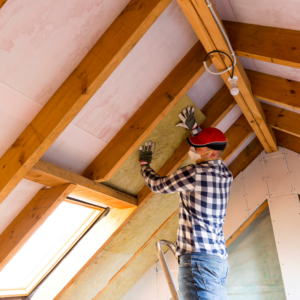Have you ever had the unsettling feeling that your home might be harboring uninvited guests? We’re here to introduce you to a revolutionary solution: rodent-proof insulation.
Rodent-proof insulation isn’t just your average home upgrade; these products can keep your home comfortable, cozy, and critter-free.
So, whether you’re dealing with a rodent problem or simply want to bolster your home’s defenses, we have what you need!
Why Do I Have a Rodent Infestation?
Rodents can easily find their way indoors through almost minuscule openings, whether a gap in the wall or a crack in the foundation. They’re not there to sightsee either; they’re ready to make themselves at home.
Rodent infestations are more than just unsettling— they can pose serious health and safety risks. Once they invade, rats and mice leave behind droppings, urine, and fur that contaminate food and spread diseases like salmonella and hantavirus.
They’re rather destructive pests, as well, chewing through anything in their path. Wires, insulation, plastic, and even wood call victim to their sharp incisors. Besides termites, rodents can cause some of the most significant damage to homes from electrical fires, water damage, and structural deterioration.
You may think that your run-of-the-mill insulation provides some protection against these unwanted visitors. After all, it’s there to keep your home cozy and secure.
But here’s the catch: traditional insulation materials are no match for determined rodents. They can chew right through them, leaving your home vulnerable to infestation and all the headaches that come with it.
But don’t worry, there’s a solution: rodent-proof insulation.
What is Rodent-Proof Insulation?
Rodent-proof insulation isn’t just extra layers— you’re getting real protection. Designed specifically to thwart the efforts of rodents, this specialized insulation serves a dual purpose: to keep your home warm and energy-efficient while providing a barrier against pesky intruders.

The fundamental difference between rodent-proof insulation and its traditional counterpart lies in how it’s made. While traditional insulation typically uses materials like fiberglass or foam board, rodent-proof insulation adds extra layers of protection to keep rodents away.
These added layers might include metal mesh, wire coatings, or scents and additives that repel mice and rats from drawing near. With its reinforced construction and durable materials, this insulation offers enhanced durability and longevity compared to traditional options.
Rodent-proof insulation maintains its effectiveness over time by resisting damage from rodents and environmental factors such as moisture and mold. Creating a tight seal against air leaks and drafts helps maintain consistent indoor temperatures, reducing the need for heating and cooling throughout the year.
Installation Considerations
The insulation comes in various forms, each with unique materials and characteristics. Common options include dense foam board, which provides a sturdy barrier against rodents. Fiberglass insulation with metal mesh reinforcement or cellulose insulation treated with rodent-repellent additives is also available.
When choosing insulation, there are several factors you’ll need to consider, such as effectiveness, durability, and cost. For instance, foam board insulation boasts excellent resistance to rodent damage and ease of installation, albeit at a potentially higher price point.
In contrast, fiberglass insulation reinforced with metal mesh offers a more budget-friendly option while providing enhanced durability against rodent intrusion. By weighing the advantages and disadvantages of each insulation type, you can make a well-informed decision that aligns with your home’s needs and budget.
You should also consider factors like the severity and location of the infestation and your budget constraints. If your home has a history of rodent infestations, investing in highly durable insulation materials may be worth the added cost for long-term protection.
Maintenance and Long-Term Care
Remember to regularly inspect your insulation and its surroundings to identify any damage or potential rodent entry points. If you notice any issues, address them promptly to maintain the insulation’s integrity and prevent rodent intrusion.
Stay vigilant for signs of rodent activity in your home, even after installing rodent-proof insulation. Here are some common indicators to watch for:
- Droppings: Keep an eye out for small, pellet-like droppings in areas where rodents are likely to frequent, such as near food sources or along walls.
- Gnaw marks: Look for chew marks on wires, insulation, or other materials, as rodents often gnaw on objects to keep their teeth trimmed.
- Unusual odors: Pay attention to any strange or musty smells, which could indicate the presence of rodents or their nesting materials.
- Rodent sightings or nests: If you see rodents scurrying around your home or find nests made of shredded materials, it’s a clear sign of an infestation.
Take immediate action at the first signs of rodent activity to stop further infestation. Don’t wait for rodents to take over—take charge with proof. Pest Control! Our expert technicians specialize in rodent control and prevention, offering customized solutions for your home.
With our Pest Free Guarantee™, rest assured we’ll eliminate and keep out rodents. Don’t let rodents rule your home; contact proof. Pest Control today for effective pest solutions and peace of mind!

